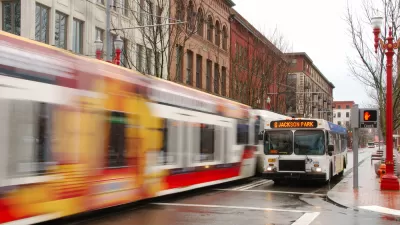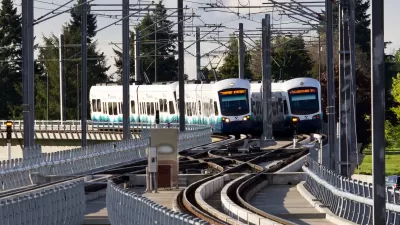Opponents of the ST3 transit funding measure in Seattle have argued that bus rapid transit is a cheaper alternative to light rail. A local write counter argues that point by making the economic case for light rail.

"A common criticism of the upcoming ST3 ballot measure is that light rail is too expensive and we’d be better off with bus rapid transit (BRT)," according to an article by Anton Babadjanov. In response to the argument for a less robust build-out of public transit infrastructure, Babadjanov examines the economics behind a range of proposed alternatives for addressing the congested state of roads around the region.
First, Babadjanov debunks the idea that wider highways would solve the Seattle region's traffic woes, based on concepts of induced demand and the massive size of the freeways that would be necessary to reach same level of lane-miles per capita as a city like Kansas City.
On the issue of buses, Babadjanov argues that for a bus to be an acceptable alternative to driving it needs to offer an alternative to traffic. Because long stretches of high-occupancy vehicle lanes are politically untenable, only new right-of-way remains as a path around congestion. But here's the rub: new right-of-way is actually the expensive part of constructing new light rail, and 80 percent of the cost for light rail in the ST3 proposal would go to right-of-way, according to Babadjanov.
So the argument goes: while Sound Transit is busy planning and building new right-of-way, it might as well make the most efficient use of it, with light rail instead of bus rapid transit.
FULL STORY: BRT Is Not Cheaper Than Light Rail

Planetizen Federal Action Tracker
A weekly monitor of how Trump’s orders and actions are impacting planners and planning in America.

Maui's Vacation Rental Debate Turns Ugly
Verbal attacks, misinformation campaigns and fistfights plague a high-stakes debate to convert thousands of vacation rentals into long-term housing.

San Francisco Suspends Traffic Calming Amidst Record Deaths
Citing “a challenging fiscal landscape,” the city will cease the program on the heels of 42 traffic deaths, including 24 pedestrians.

Amtrak Rolls Out New Orleans to Alabama “Mardi Gras” Train
The new service will operate morning and evening departures between Mobile and New Orleans.

The Subversive Car-Free Guide to Trump's Great American Road Trip
Car-free ways to access Chicagoland’s best tourist attractions.

San Antonio and Austin are Fusing Into one Massive Megaregion
The region spanning the two central Texas cities is growing fast, posing challenges for local infrastructure and water supplies.
Urban Design for Planners 1: Software Tools
This six-course series explores essential urban design concepts using open source software and equips planners with the tools they need to participate fully in the urban design process.
Planning for Universal Design
Learn the tools for implementing Universal Design in planning regulations.
Heyer Gruel & Associates PA
JM Goldson LLC
Custer County Colorado
City of Camden Redevelopment Agency
City of Astoria
Transportation Research & Education Center (TREC) at Portland State University
Jefferson Parish Government
Camden Redevelopment Agency
City of Claremont





























